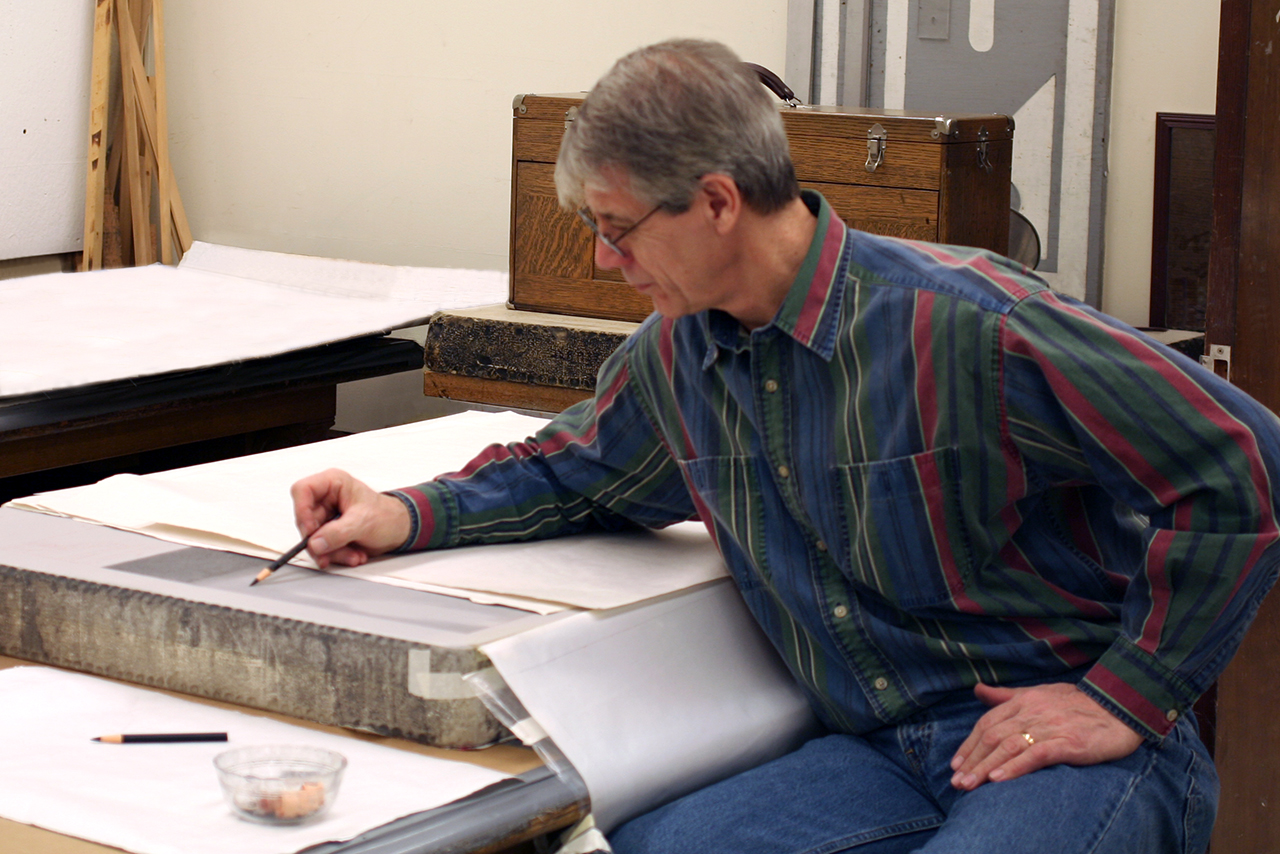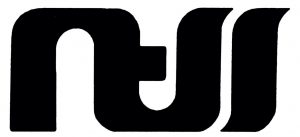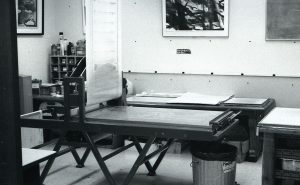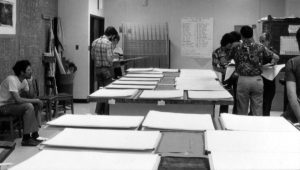Recently Professor Sarah Smelser met with Illinois State University’s Distinguished Professor Emeritus James D. Butler, one of the founders of Normal Editions.
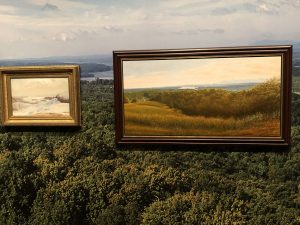
Framed paintings by James D. Butler (right) “A View of Olana,” oil on panel, and a mid-1800’s Frederic Edwin Church (left) of the same site in the context of a large-scale photograph of the site as seen in Hudson Rising exhibition, New-York Historical Society, New York, NY, March 1-August 4, 2019
James D. Butler taught lithography at Illinois State University from 1976 to 2009, during which time he exhibited his work widely in 40 solo exhibitions, 280 invitational/group exhibitions, and 350 competitive exhibitions. He has been a visiting artist in over 80 universities and his work is included in over 100 publications. He is the recipient of two Illinois Arts Council Fellowships and two National Endowment Artist Fellowships. His works are in such prestigious collections as The Metropolitan Museum of Art, The Whitney Museum of American Art, The Chicago Art Institute, the Brooklyn Museum, and The Philadelphia Museum of Art. In 2003 Butler was honored with the Alumnus Achievement Award in Art and Art History at the University of Nebraska, Lincoln; and in 2012 he received the Mid America Print Council Outstanding Printmaker Award.
SS: For readers who are not familiar with Normal Editions, can you describe its intended and ideal function within an educational setting? What did it bring to Illinois State University? Was there a model that you looked to?
JB: My intention when establishing Normal Editions Workshop, in the fall of 1976, was to provide an open, concept-sharing experience for our students. Normal Editions, a print research facility, gives our students a first-hand insight into aesthetic considerations being made by artists with national and regional reputations. I insisted that the shop be an integral part of the academic unit. By doing so, all students and faculty from the Wonsook Kim School of Art would feel welcome in the shop while meeting each visiting artist, and perhaps even participate in projects.
In the beginning, Normal Editions was directed by Master Printer Richard Finch. Later, Veda Rives Aukerman became Associate Director. Ms. Aukerman is now the Interim Director and is assisted by Professor Sarah Smelser and Associate Professor Morgan Price. Throughout Normal Edition’s history, faculty and staff, together with our undergraduate and graduate students, collaborate with visiting artists creating new and exciting works of art. Each experience is unique and at times challenging for all involved.
Students can easily get “bound” to a style and a singular way of approaching their work. In our shop, through these encounters, they are taught to think independently, both aesthetically and technically. Students who work on these projects are required to respect the demands of the artist to produce an exceptional work of art. The expectations and pressures when working on an artist’s project are very high, something they may never have experienced before.
An ideal function of Normal Editions within an educational setting begins with faculty and staff who are committed to making this program succeed. It takes people who are professional, have very high standards for all aspects of the program, and are able to coordinate with many different personalities. We have been very fortunate that everyone on the faculty and staff have been willing to contribute in so many positive ways.
The faculty have always had to be flexible when working on projects that seem to have a life of their own. One has to adapt to the time commitment when this happens. We also had to find ways to operate in a very limited space that was never really designed to accommodate a visiting artist workshop. Normal Editions could be even more productive if and when their space is enlarged and properly designed.
We always faced the challenge of funding for the Normal Editions visiting artist program. There have been many times that we were not able to attract a nationally known artist because we did not have the money to pay their fees. During my time at Illinois State University, Richard and Veda were quite an accomplished team at writing grants for projects. As well, they did contract printing to help raise funds for the operation of Normal Editions. So, for Normal Editions to operate “on all cylinders”, working in a more functional space that has been designed for the needs of the visiting artist program, funding Normal Editions properly and turning the Interim Director title into a full-fledged Director’s title should be goals for the administration.
The contributions that have been made to Illinois State University by having the Normal Editions on campus for forty-four years have been incredibly impressive. Normal Edition’s visiting artist program served any studio area that wished to have their visiting artists and students participate. So, the influence of Normal Editions has had a ripple effect in the School of Art. There are former students from all disciplines who have been influenced by experiences in Normal Editions. These students continually return to thank faculty for the positive influences that were made on their lives.
There have been over 140 artists who have worked at Normal Editions. These artists continually speak highly of their experiences and many have returned to produce new prints. For every print project there are two prints archived for the Illinois State collection. There has been over 280 print projects and the value of these archived prints is considerable. Of course, these prints are accessible to students and faculty for study/teaching purposes. Over the years, Normal Editions has had many requests for exhibitions of our collection, so there have been traveling shows throughout the United States. Unquestionably, the reputation of the Wonsook Kim School of Art has been enhanced because of Normal Edition’s national profile.
In 2007, Normal Editions celebrated its 30th anniversary and hosted a three-day conference entitled “Frontiers in Printmaking.” There were presenters from around the world. This conference raised the Wonsook Kim School of Art’s international profile. We also published a book, Marks from the Matrix, that cataloged many of the accomplishments of Normal Editions. This book is a great resource for students and scholars in the field of printmaking. In so many ways, it highlights the significance of Normal Editions to Illinois State University.
Tamarind Institute at the University of New Mexico provided a preliminary model for creating Normal Editions. However, the mission of Tamarind Institute is to train printers, specifically lithographers. Our mission is to teach artists and all print disciplines are available to help accomplish this goal.
SS: What was your experience with professional print shops before you founded Normal Editions?
JB: My experience with other professional print shops included several summers making lithographs at the Tamarind Institute, Landfall Press in Chicago, Mourlot in Paris, and Echo Press at Indiana University Bloomington. In each case, I worked with a master printer who prepared the stones and plates for editioning and printed the edition for me.
These experiences, especially Tamarind, Landfall, and Mourlot shaped my thinking about collaborative printing and what Normal Editions could be. The 1970’s were an exciting time for artists interested in prints. There was a profound interest in reviving older print processes such as lithography and finding fresh and innovative ways to make intaglio prints. Many of the older, somewhat dogmatic approaches to intaglio work were being pushed aside in favor of more experimental techniques.
It was an exciting time to be involved in printmaking as there were many visiting artist opportunities for printmakers. There were conferences, symposiums and workshops where ideas were freely exchanged. Richard Black, at Drake Prints in Des Moines, Iowa had a symposium every two years and invited artists and students from across the country; most disciplines were represented sometime during a multiyear time span. We always took interested students in an attempt to give them new and varied perspectives on printmaking. Lloyd Menard, at the University of South Dakota, Vermillion, had a two-week print marathon, which included serigraphers, intaglio printmakers and lithographers creating and printing their own editions while on campus, one group each week. Once again, we took students from the program.
It seemed like many ambitious faculty were attempting to provide these experiences on their campuses. There were short blasts of energy, usually the visiting printmakers were responsible for printing their own editions, and then the activity was over until the next time…sometimes two years, sometimes never, especially when the energy and funding ran out.
My experiences with these events shaped the way I thought about a different kind of experience for students. These events ended up being a kind of show and tell and the quality of the work completed usually depended upon the facilities in which the program was held. I was never very satisfied with the work I produced under those circumstances.
I taught at Southern Illinois University-Edwardsville from 1970 through 1975 and I invited many artists to campus to make prints. I always included students in the collaboration and I usually printed the editions. However, I also created a work study/college credit program with Jack Lemon at Landfall Press in Chicago, where students could go, live in the multistoried shop and work on very complex prints. The experiences they brought back to the shop were extraordinary…so much so, that it seemed that this kind of serious engagement was much more beneficial than a workshop here and a workshop there. Those students that finished that work-study program came back to campus and were prepared to print artists’ editions. Of course, whoever took advantage of that opportunity had to make sacrifices, and only one student at a time could participate.
So, in 1975, my colleague, Robert Malone and I established a contract/visiting artist component to the shop at Southern Illinois University-Edwardsville. We hired a former student, Steve Britko, a Tamarind Master printer, and we were off and running. I learned much from those times and carried those experiences with me when starting Normal Editions at Illinois State in 1976.
SS: What were the challenges you faced in establishing Normal Editions and get it running?
JB: Robert Malone and I were told in 1975, by a very experienced printmaker, that this kind of program was impossible in a university. That is a challenging statement to make, yet there is much truth to it. It required many people believing in the benefits of such a program, for the students engaged, for the university as a whole and for the artists that had the faith to trust us with their work.
I knew we had the ability to handle all of this, but it was still a difficult task. We had to carve out a space in the lithography shop for a press, share everything with the lithography program, i.e. budget, stones, plates, make all facilities common, such as the graining sink, processing tables, lightroom, etc. It really goes on forever, but it really doesn’t matter, because we made it work! It was all about working toward one goal, providing an exciting and educational experience for students.
As I mentioned before, Normal Editions had to be integrally connected to the print studios. We had to find a master printer/director who had the same interests for the program. Richard Finch was that person and had the right temperament, knowledge and willingness to sacrifice for the program. There really would not be a Normal Editions if it wasn’t for Richard, later Veda, and now Sarah and Morgan.
Ray George and Harold Boyd were strong supporters as was Dr. Fred Mills and Dean Charles Bolen. Ray and Harold provided moral support while Chair Mills and Dean Bolen provided financial help to get the program off the ground. Still, there were so many challenges as the School of Art did not have a budget that could really support the shop, making every issue bigger than it should have been.
One could write a paper about all of the obstacles we encountered while establishing Normal Editions. In this context, I would say, as I told our daughter when she was facing a difficult task in music or sports: “You have to love the process.” We did, through all of the frustrations and hard work, we could see the students’ positive responses to everything they received. It was worth it!
SS: What role did you play once Normal Editions was well established within the printmaking area and the Wonsook Kim School of Art?
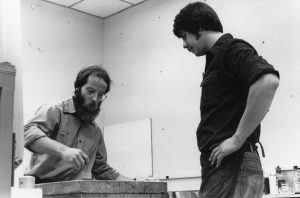
Richard Finch and James D. Butler processing an artist’s drawing on a stone in a scene from the early days of Normal Editions, 1977
JB: In the early days of Normal Editions, my role was to support the program in any way possible. That role never changed. However, when it was just Richard and me making sure that projects would be completed properly, I spent much time assisting with prints. From time to time, I would collaborate with an artist and print the edition. However, I sponged, helped with paper preparation and assisted in the final curating of the prints, especially if we did not have students available or qualified for the technical needs of the job. I should mention that Ray George assisted many times on projects. It really was a team approach. Our goal was to spread out the work and successfully complete each project.
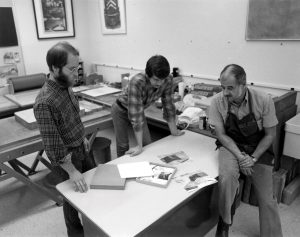
Richard Finch, Jim Butler, and Ray George discussing options for a collaborative project in the late 1970’s
Richard was the Director of Normal Editions and was always in charge. As the program matured, I acted more as a sounding board for Richard and Veda if they wanted another opinion. Those two worked so well together and thought things out so thoroughly, they really didn’t need another opinion. I was always available to help on a print project, or with other material needs, especially when it came to budget shortfalls. We always worked together when it came to facility needs. I respected Richard’s opinions, and then Veda’s too, when it came to recruiting graduate students. Eventually, Normal Editions was able to offer some financial assistance to graduate students and it was imperative that they had input when it came to recruiting students.
Normal Editions hosted several major summer workshops when Richard and I worked together to promote and carry out a successful portfolio of prints for participants from the U.S. and Canada. Again, we saw the value of these projects, for the students involved and for spreading a positive reputation for Illinois State.
In the beginning, Richard, Ray and I ran the annual Holiday Print Exhibition Sale. It was a way for the Bloomington-Normal public to notice our programs and provided some money for many of our print students. It is just a day of very positive feelings about Illinois State!
The “Frontiers in Printmaking,” in 2007, was a monumental collaborative effort for Richard, Veda, Sarah and me. The book Marks from the Matrix was also a very important part of that conference. We all worked tirelessly to have both of these projects succeed. These two events underscore the culture within the print program, where faculty are willing to take on major events for the good of the program. I see myself as just one of those team players and I am proud to have been associated with such wonderful colleagues.
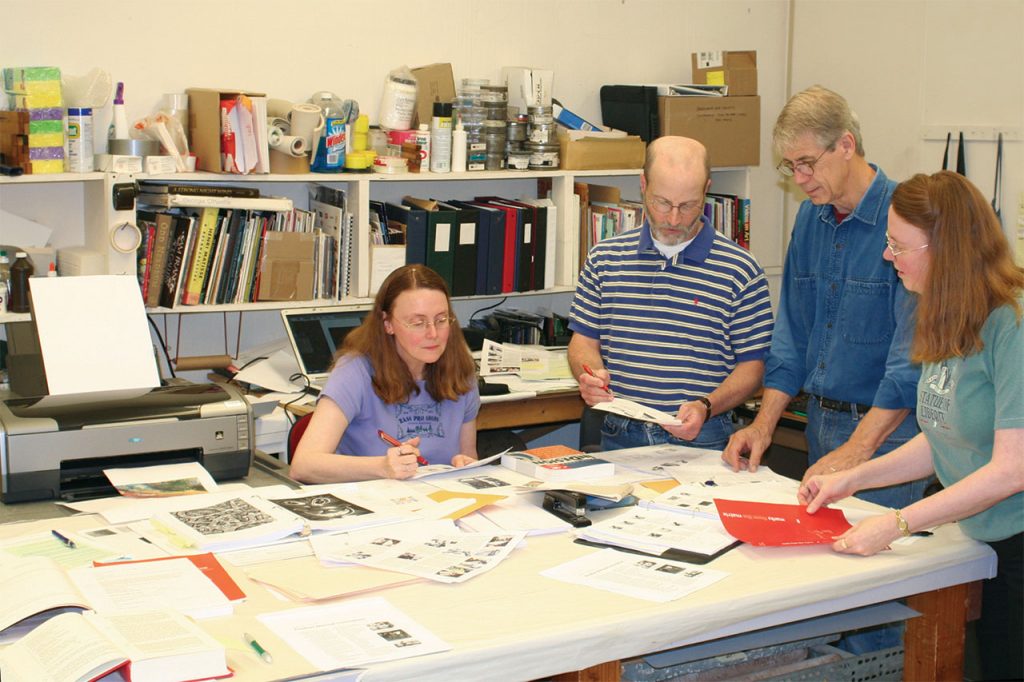
Veda Rives, Richard Finch, James D. Butler, and Meda Rives during a consultation in the creation of the publication Marks from the Matrix documenting the first thirty years of Normal Editions Workshop
